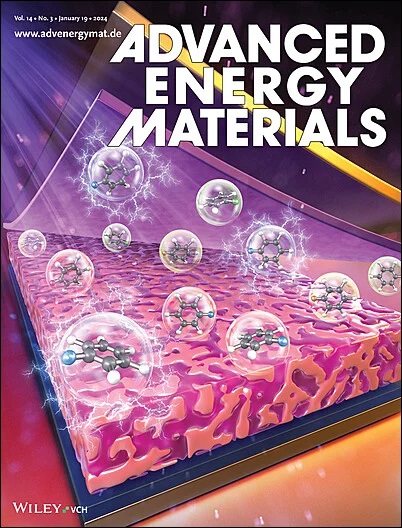构建不对称Ir - O - Ru单元促进PbIrRu焦绿石快速脱质子和稳定晶格氧用于水氧化
IF 24.4
1区 材料科学
Q1 CHEMISTRY, PHYSICAL
引用次数: 0
摘要
探索高效、耐用的低铱(Ir)催化剂用于析氧反应(OER)对质子交换膜电解(PEMWE)的商业化至关重要。本文通过可扩展的水热策略将钌(Ru)位点掺入PbIrRu焦绿石(Pb2(IrRu)2O7−δ),在PbIrRu焦绿石中构建了不对称Ir - O - Ru活性单元。软X射线吸收光谱、操作分子表征和DFT计算表明,Ir - O - Ru单元通过打破[IrO6]八面体单元中桥氧对称性来调节氧的电荷分布,从而促进氧中间体(*OH→*O)的快速去质子化,从而提高OER动力学。Operando差分电化学质谱分析表明,在OER催化过程中,这些不对称单元还通过加强金属-氧键来稳定晶格氧,从而抑制金属氧化/溶解,从而有助于提高OER耐久性。优化后的Pb2(IrRu)2O7−δ在10 mA cm−2下具有188 mV的低过电位,在0.5 m H2SO4中具有1290.2 a g−1Ir+Ru的高质量活性(分别是商用IrO2和RuO2的16.4和46.7倍)。组装的PEMWE阳极负载为~ 0.36 mgIr+Ru cm - 2,在1.72 V电压下可达到1 A cm - 2,在高电流密度下可持久工作300小时,衰减可忽略不计。这项工作为设计用于PEMWE的高性能焦绿盐基低Ir催化剂提供了新的见解。本文章由计算机程序翻译,如有差异,请以英文原文为准。
Constructing Asymmetric Ir‐O‐Ru Unit to Promote Rapid Deprotonation and Stable Lattice Oxygen in PbIrRu Pyrochlores for Water Oxidation
Exploring efficient and durable low‐iridium (Ir) catalysts for the oxygen evolution reaction (OER) is crucial for the commercialization of proton exchange membrane water electrolysis (PEMWE). Herein, asymmetric Ir‐O‐Ru active units are constructed in PbIrRu pyrochlore (Pb2 (IrRu)2 O7−δ ) by incorporating ruthenium (Ru) sites into PbIr pyrochlore through a scalable hydrothermal strategy. Soft X‐ray absorption spectroscopy, operando characterizations, and DFT calculations reveal that the Ir‐O‐Ru units promote rapid deprotonation of oxo‐intermediates (*OH→*O) for enhancing OER kinetics by modulating charge distribution of oxygen through breaking bridged‐oxygen symmetry in [IrO6 ] octahedral units. Operando differential electrochemical mass spectrometry demonstrates that these asymmetric units also stabilize lattice oxygen during OER catalysis by strengthening metal‐oxygen bonds, which suppresses metal oxidation/dissolution and thus contributes to a superior OER durability. The optimized Pb2 (IrRu)2 O7−δ exhibits a low overpotential of 188 mV at 10 mA cm−2 and a large mass activity of 1290.2 A g−1 Ir+Ru (16.4 and 46.7 times that of commercial IrO2 and RuO2 , respectively) in 0.5 m H2 SO4 . The assembled PEMWE with anode loading of ∼0.36 mgIr+Ru cm−2 achieves 1 A cm−2 at 1.72 V and durably operates for 300 h at high current density with negligible attenuation. This work provides new insights into designing high‐performance pyrochlore‐based low‐Ir catalysts for PEMWE applications.
求助全文
通过发布文献求助,成功后即可免费获取论文全文。
去求助
来源期刊

Advanced Energy Materials
CHEMISTRY, PHYSICAL-ENERGY & FUELS
CiteScore
41.90
自引率
4.00%
发文量
889
审稿时长
1.4 months
期刊介绍:
Established in 2011, Advanced Energy Materials is an international, interdisciplinary, English-language journal that focuses on materials used in energy harvesting, conversion, and storage. It is regarded as a top-quality journal alongside Advanced Materials, Advanced Functional Materials, and Small.
With a 2022 Impact Factor of 27.8, Advanced Energy Materials is considered a prime source for the best energy-related research. The journal covers a wide range of topics in energy-related research, including organic and inorganic photovoltaics, batteries and supercapacitors, fuel cells, hydrogen generation and storage, thermoelectrics, water splitting and photocatalysis, solar fuels and thermosolar power, magnetocalorics, and piezoelectronics.
The readership of Advanced Energy Materials includes materials scientists, chemists, physicists, and engineers in both academia and industry. The journal is indexed in various databases and collections, such as Advanced Technologies & Aerospace Database, FIZ Karlsruhe, INSPEC (IET), Science Citation Index Expanded, Technology Collection, and Web of Science, among others.
 求助内容:
求助内容: 应助结果提醒方式:
应助结果提醒方式:


